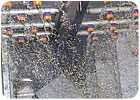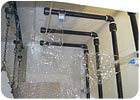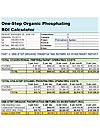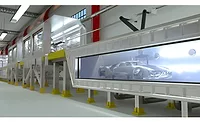One-Step Metal Pretreatment
Metal preparation is in many ways a dirty business. Improvements have been made in the painting phase of the operation, including a general switch to high-solids liquids and powder coatings. But pretreatment has not changed much in many years. However, starting in 2000, a different kind of pretreatment was introduced in North America. This single-stage organic phosphating system is reducing the cost and environmental impact of pretreating metal substrates.

Metal preparation is in many ways a dirty business. Improvements have been made in the painting phase of the operation, including a general switch to high-solids liquids and powder coatings. But pretreatment has not changed much in many years.
However, starting in 2000, a different kind of pretreatment was introduced in North America. The technology was developed in Italy in the 1980s by inventor and chemical engineer Dr. Gianluigi Guidetti, owner of PaiKor srl of Milan, Italy, who designed the phosphating system expressly to be “green.” Understanding the environmental issues surrounding conventional finishing systems, Guidetti decided to look at the problem of pretreatment from the bottom up, from a new and more environmentally friendly standpoint, as well as from a cost-saving perspective. The result, a single-stage organic phosphating system,* is changing the way many metal finishers approach the pretreatment process.

One common misunderstanding based on conventional technology is that a single-stage process cannot yield good results. In a conventional system, each stage performs a different function and cannot be combined with another stage. A single-stage water-based system therefore would accomplish only one step, such as cleaning, but not others such as rinsing, phosphating or applying a sealant. However, the single-stage organic phosphating system is not water-based, and all steps can be combined because of the different chemistry.
In the single minute of treatment time, several different functions are performed. The oils and fines (dust and grinding materials) are washed off the parts by the solvents, which simultaneously solubilize the oils. The phosphoric acid in the bath then reacts with the metal surface, creating an inorganic phosphate layer out of the substrate metal. On steel, that phosphate layer is iron phosphate, while on galvanized metal it is zinc phosphate. On aluminum, no phosphate layer is created; however, adhesion promotion and corrosion resistance are developed from cleaning, etching and sealing.
After the washing and creation of the phosphate layer, the part is ready to be removed from the bath. The excess solution runs off the part (it also can be blown off) and is recycled to the tank for further use. The fines that are removed from the parts at the beginning of the one-minute treatment time are separated from the bath by a bag filtration system.
The next stage of the process occurs during dry-off. As stated previously, the oils are removed from the parts and solubilized in the solvents during treatment. A special resin in the bath is capable of absorbing up to four times its own weight in process oils. This capability translates to an average of four times the amount of oil found on cold-rolled steel. The oils removed from the parts by the solvents in the bath are transferred to the resin, and that resin, in turn, exits the bath on the treated parts.
When the parts are dried, the resin remains on the surface and performs two important functions. First, it forms a continuous seal on the parts to prevent flash rust for weeks before painting. Second, it chemically captures the oils (which cannot migrate to the surface and interfere with adhesion) and uses them as a plasticizer. The captured oils lend flexibility to the resin and increase resistance to cracking and chipping, thereby improving the adhesion of the topcoat.
No water is used in the process, and no post-rinse is required. This means that no pollutants enter the water stream, and no water hookups or permits are required. The process avoids the entire issue of phosphates as an effluent, as well as other plant waste that could find itself in the wastewater.
In contrast to a conventional system, the single-stage organic phosphating process creates no sludge or other solid byproducts. The only solids to be disposed of are the fines that came in on the parts in the first place.
In a conventional system, process oils removed from the parts are a significant waste. In the organic phosphating pretreatment system, the oils are not skimmed and dumped, but are instead captured and used as the plasticizer in the resin seal.
Since the process operates at ambient temperatures, the pretreatment bath does not need natural gas or any other thermal energy. This fact represents both an increasingly significant cost savings and an environmental benefit.
The process also requires minimal electrical energy because it is a single-stage, low-pressure and low-exhaust technology that uses fewer and smaller pumps and fans compared to conventional pretreatment methods. In a spray system, the spray pressure (actually a flowcoat) is only 3 to 5 psi. Exhaust is minimal and is just enough to create a little negative air pressure from the plant into the tunnel.
While the single-stage organic phosphating system uses solvents rather than water to perform the cleaning function, the solvents accomplish several process and environmental goals. Their hydrogen bonding values and solubility characteristics make them highly efficient at absorbing the normal range of process oils. In addition, the solvents are low-emission because they have high flashpoints (ranging from 149 to >212°F [65 to >100°C]) and high boiling points (from 338 to 444°F [170 to 229°C]), as well as low vapor pressures (from 0.85 to 0.02 mm of mercury). To put the vapor pressure issue in context, regulations in San Diego, CA, permit the use of solvents with a vapor pressure of less than 20 mm of mercury (assuming that the solvents meet other requirements, which the single-stage organic phosphating chemicals do). Regulations in other jurisdictions permit the use of the process based on the high boiling points of the solvents.
The solvents are also environmentally sound because of what they do not contain - no hazardous air pollutants, no carcinogens or mutagens, no halogenated compounds or chlorofluorocarbons, and no ozone-depleting substances. The only substance in the solvents that goes to atmosphere is volatile organic compounds (VOCs), and even those are emitted at a low level because of the low vapor pressure and high flashpoints. Taking a mid-range product as an example, a user treating 50,000 ft2 of metal in a properly designed spray plant will emit only 170 lb of VOCs. In a dip plant treating the same amount of metal, the emissions will be just over 100 lb.
Less stable compounds degrade faster and do not migrate to the stratosphere. The single-stage organic phosphating solvents biodegrade in a matter of hours to days (depending on temperature, humidity and sunlight), and the products of degradation are only carbon dioxide (CO2) and water.
While CO2 is said to be a major contributor to global warming, the amount emitted by the organic phosphating solvents is small compared to the large volumes generated by the combustion of natural gas. The lower emissions are because organic phosphating is an ambient temperature process that uses low-emitting solvents, and because the percentage of carbon contained in the special solvents is considerably lower than the amount contained in natural gas.
An analytical comparison was made between the single-stage organic phosphating process and three actual plants running conventional heated pretreatment washers. The comparison assumed that the organic phosphating processes were treating the same amount of metal. For each of the plants studied, only 5 to 12% the amount of carbon dioxide would be created with the organic phosphating process compared to the amount those conventional plants actually create using fuel combustion to heat their process tank water. The three plants studied treat varying amounts of metal per day, used different-sized burners (varying BTU consumption), and have different production efficiencies. These factors explain the 5 to 12% range in comparative results, and would represent normal variations in a production process.
The one-step organic phosphating system yields corrosion resistance performance that is somewhat superior to conventional iron phosphating on steel. The actual number of salt spray hours depends on the quality and thickness of the topcoat. On galvanized steel, since the phosphate layer is zinc, the corrosion resistance is much higher. On aluminum, tests show results of over 2,000 hours with good quality topcoats, and a test with Kynar yielded more than 4,000 hours. Nonetheless, one area of continued development is a formulation designed particularly for higher levels of corrosion resistance.

*The single-stage organic phosphating system is distributed by Carpenter Chemicals, Alexandria, VA, under the tradename Plaforization™. For more information, visit www.cc-lc.com.
Environmental Efficiency
A major part of this effort involves the concept of environmental efficiency. This means minimizing the number of elements in a process and giving each element an active function (or more than one). Such “multitasking” minimizes the number and quantity of components in the process that ultimately must be disposed of as “waste.” For example, water is used in a conventional pretreatment process and ultimately must be treated and discharged.
Part of the environmental efficiency concept involves avoiding the creation of wastes in a process. As an example, conventional metal pretreatment processes create sludge, which then must be disposed of. The single-stage organic phosphating process was designed specifically to avoid creating sludge.
Another aspect of environmental efficiency is to avoid having to periodically dispose of the bath itself. In contrast to water-based systems, the single-stage organic phosphating system uses up the bath ingredients in proportion, so the process does not easily go out of balance. Because of this high stability, the bath is never dumped, just checked periodically and adjusted (“topped off”) as necessary.
Resource Recovery
Another layer of the total environmental approach is resource recovery, which means recycling potential pollutants within the production system and reusing them in the same or other processes. For example, the solvents in the single-stage organic phosphating process have high flashpoints/boiling points and low vapor pressure, and are therefore mostly returned to the tank rather than being evaporated.
Material Substitution
Material substitution offers the prospect of completely eliminating a given pollution problem by substituting a different element or process. (Of course, as noted above, it is not permissible merely to shift a problem from one system to another, such as air to water or vice-versa.) A major substitution in the single-stage organic phosphating system is that it uses no water at all in the pretreatment and is not rinsed. It uses solvents instead, and the solvents themselves are particularly selected for their “air degradability” and their precise functionality in the process.
Good Housekeeping
Finally, good housekeeping in a plant has an enormous positive impact on pollution control. Efficient operation saves money, minimizes large capital expenditures, and can cut pollution by as much as one-third. The single-stage organic phosphating process was designed for simplicity of operation, and efficiency is easier to achieve when maintenance and operations are simple.

In the single minute of treatment time, the oils and fines are washed off the parts by the solvents, which simultaneously solubilize the oils. The phosphoric acid in the bath then reacts with the metal surface, creating an inorganic phosphate layer out of the substrate metal.
Metal preparation is in many ways a dirty business. Improvements have been made in the painting phase of the operation, including a general switch to high-solids liquids and powder coatings. But pretreatment has not changed much in many years.
However, starting in 2000, a different kind of pretreatment was introduced in North America. The technology was developed in Italy in the 1980s by inventor and chemical engineer Dr. Gianluigi Guidetti, owner of PaiKor srl of Milan, Italy, who designed the phosphating system expressly to be “green.” Understanding the environmental issues surrounding conventional finishing systems, Guidetti decided to look at the problem of pretreatment from the bottom up, from a new and more environmentally friendly standpoint, as well as from a cost-saving perspective. The result, a single-stage organic phosphating system,* is changing the way many metal finishers approach the pretreatment process.

A part is treated for 60 to 90 seconds in the liquid and is then removed, dripped/blown off and dried, and is ready to be painted.
Technology Basics
The single-stage, no-rinse dip or spray process operates at ambient temperatures (from 60 to more than 100°F [16 to >38°C] in-plant temperatures). A part is treated for 60 to 90 seconds in the liquid and is then removed, dripped/blown off and dried, and is ready to be painted. The part also can be stored for weeks before finishing because it does not flash rust.One common misunderstanding based on conventional technology is that a single-stage process cannot yield good results. In a conventional system, each stage performs a different function and cannot be combined with another stage. A single-stage water-based system therefore would accomplish only one step, such as cleaning, but not others such as rinsing, phosphating or applying a sealant. However, the single-stage organic phosphating system is not water-based, and all steps can be combined because of the different chemistry.
In the single minute of treatment time, several different functions are performed. The oils and fines (dust and grinding materials) are washed off the parts by the solvents, which simultaneously solubilize the oils. The phosphoric acid in the bath then reacts with the metal surface, creating an inorganic phosphate layer out of the substrate metal. On steel, that phosphate layer is iron phosphate, while on galvanized metal it is zinc phosphate. On aluminum, no phosphate layer is created; however, adhesion promotion and corrosion resistance are developed from cleaning, etching and sealing.
After the washing and creation of the phosphate layer, the part is ready to be removed from the bath. The excess solution runs off the part (it also can be blown off) and is recycled to the tank for further use. The fines that are removed from the parts at the beginning of the one-minute treatment time are separated from the bath by a bag filtration system.
The next stage of the process occurs during dry-off. As stated previously, the oils are removed from the parts and solubilized in the solvents during treatment. A special resin in the bath is capable of absorbing up to four times its own weight in process oils. This capability translates to an average of four times the amount of oil found on cold-rolled steel. The oils removed from the parts by the solvents in the bath are transferred to the resin, and that resin, in turn, exits the bath on the treated parts.
When the parts are dried, the resin remains on the surface and performs two important functions. First, it forms a continuous seal on the parts to prevent flash rust for weeks before painting. Second, it chemically captures the oils (which cannot migrate to the surface and interfere with adhesion) and uses them as a plasticizer. The captured oils lend flexibility to the resin and increase resistance to cracking and chipping, thereby improving the adhesion of the topcoat.
Environmental Profile
The single-stage organic phosphating process is basically a self-contained system that uses up its own materials in proportion. Because of this characteristic, the bath never needs to be dumped and recharged, but just topped off as needed. The fines that come in on the parts are filtered out; the oils are removed continuously by being trapped in the resin and taken out on the parts; and the resin, fluid and phosphoric acid in the solution are used up in proportion. The process is so stable that laboratory bath analyses only need to be performed every two months instead of hourly or daily, as is often required with conventional pretreatment systems.No water is used in the process, and no post-rinse is required. This means that no pollutants enter the water stream, and no water hookups or permits are required. The process avoids the entire issue of phosphates as an effluent, as well as other plant waste that could find itself in the wastewater.
In contrast to a conventional system, the single-stage organic phosphating process creates no sludge or other solid byproducts. The only solids to be disposed of are the fines that came in on the parts in the first place.
In a conventional system, process oils removed from the parts are a significant waste. In the organic phosphating pretreatment system, the oils are not skimmed and dumped, but are instead captured and used as the plasticizer in the resin seal.
Since the process operates at ambient temperatures, the pretreatment bath does not need natural gas or any other thermal energy. This fact represents both an increasingly significant cost savings and an environmental benefit.
The process also requires minimal electrical energy because it is a single-stage, low-pressure and low-exhaust technology that uses fewer and smaller pumps and fans compared to conventional pretreatment methods. In a spray system, the spray pressure (actually a flowcoat) is only 3 to 5 psi. Exhaust is minimal and is just enough to create a little negative air pressure from the plant into the tunnel.
While the single-stage organic phosphating system uses solvents rather than water to perform the cleaning function, the solvents accomplish several process and environmental goals. Their hydrogen bonding values and solubility characteristics make them highly efficient at absorbing the normal range of process oils. In addition, the solvents are low-emission because they have high flashpoints (ranging from 149 to >212°F [65 to >100°C]) and high boiling points (from 338 to 444°F [170 to 229°C]), as well as low vapor pressures (from 0.85 to 0.02 mm of mercury). To put the vapor pressure issue in context, regulations in San Diego, CA, permit the use of solvents with a vapor pressure of less than 20 mm of mercury (assuming that the solvents meet other requirements, which the single-stage organic phosphating chemicals do). Regulations in other jurisdictions permit the use of the process based on the high boiling points of the solvents.
The solvents are also environmentally sound because of what they do not contain - no hazardous air pollutants, no carcinogens or mutagens, no halogenated compounds or chlorofluorocarbons, and no ozone-depleting substances. The only substance in the solvents that goes to atmosphere is volatile organic compounds (VOCs), and even those are emitted at a low level because of the low vapor pressure and high flashpoints. Taking a mid-range product as an example, a user treating 50,000 ft2 of metal in a properly designed spray plant will emit only 170 lb of VOCs. In a dip plant treating the same amount of metal, the emissions will be just over 100 lb.
Air Degradability and CO2 Emissions
Another aspect of the VOC issue is “air degradability.” This concept relates to the manner in which VOCs degrade in the atmosphere and how that impacts their effect on the atmosphere. Chlorofluorocarbons (CFCs), for example, cause ozone depletion, and it is believed that the long half-life of these chemicals in the atmosphere has a direct correlation with ozone depletion. For example, it is known that compounds that have a long half-life and thus reach the stratosphere decompose when exposed to UV radiation, releasing chlorine and bromine, which destroy ozone molecules.Less stable compounds degrade faster and do not migrate to the stratosphere. The single-stage organic phosphating solvents biodegrade in a matter of hours to days (depending on temperature, humidity and sunlight), and the products of degradation are only carbon dioxide (CO2) and water.
While CO2 is said to be a major contributor to global warming, the amount emitted by the organic phosphating solvents is small compared to the large volumes generated by the combustion of natural gas. The lower emissions are because organic phosphating is an ambient temperature process that uses low-emitting solvents, and because the percentage of carbon contained in the special solvents is considerably lower than the amount contained in natural gas.
An analytical comparison was made between the single-stage organic phosphating process and three actual plants running conventional heated pretreatment washers. The comparison assumed that the organic phosphating processes were treating the same amount of metal. For each of the plants studied, only 5 to 12% the amount of carbon dioxide would be created with the organic phosphating process compared to the amount those conventional plants actually create using fuel combustion to heat their process tank water. The three plants studied treat varying amounts of metal per day, used different-sized burners (varying BTU consumption), and have different production efficiencies. These factors explain the 5 to 12% range in comparative results, and would represent normal variations in a production process.
Application Range
The one-step organic phosphating technology can be used for a variety of metal pretreatment applications. Plants that rely on air drying rather than using a dry-off oven can use a faster evaporating (30 minute evaporation time) formulation, as long as sufficient time is available for the drying at room temperature. Users that employ an oven to decrease process time can use higher-flashpoint, very-low-vapor-pressure formulations, which are lower-emitting in terms of VOCs and do not evaporate at room temperature. These formulations are particularly appropriate for use in areas in which in-plant temperatures are above 85°F (29°C) for significant periods. Other formulations can be used in conjunction with a scrubber in high-production environments, in which the scrubber would be used to recover and recycle most of the solvent vapors that would otherwise be exhausted. The production rate must be reasonably high to qualify for this process because there is a constant equilibrium loss that must be overcome before the scrubber becomes efficient.The one-step organic phosphating system yields corrosion resistance performance that is somewhat superior to conventional iron phosphating on steel. The actual number of salt spray hours depends on the quality and thickness of the topcoat. On galvanized steel, since the phosphate layer is zinc, the corrosion resistance is much higher. On aluminum, tests show results of over 2,000 hours with good quality topcoats, and a test with Kynar yielded more than 4,000 hours. Nonetheless, one area of continued development is a formulation designed particularly for higher levels of corrosion resistance.

Figure 1. An ROI calculator determined that one company treating 10,000 ft2 of metal per day and paying $1.00 per therm for natural gas saves $111,000 per year using the one-step organic phosphating process.
Capital and Operating Costs
When comparing capital and operating costs to conventional systems, the single-step process is both efficient and cost-effective. For example, one company treating 10,000 ft2 of metal per day and paying $1.00 per therm for natural gas saves $111,000 per year using the one-step process (see Figure 1). Another manufacturer brought production back from China on the basis of the cost savings from the process.Environmentally Sound Pretreatment
The single-stage organic phosphating process is continuing to gain momentum in the North American metal pretreatment market. From an operational standpoint, the process is simple and does not require the long and complicated installation of a conventional system. That means less maintenance, no sludge issues, no water treatment issues, and a stable bath with only infrequent bath checks and adjustments. Because there is no water in the process, users need no water permits, and air permits are also often unnecessary. Some companies also proactively seek out environmentally friendly processes. Many jurisdictions provide financial incentives for such systems. Modern metal finishers are finding the environmental benefits to be important, and they appreciate being able to pretreat in an environmentally sound manner.*The single-stage organic phosphating system is distributed by Carpenter Chemicals, Alexandria, VA, under the tradename Plaforization™. For more information, visit www.cc-lc.com.
SIDEBAR: Developing an Environmentally Sound Technology
Minimizing the overall environmental impact of a product or process involves a multilayered approach. The concept requires taking a “global” look at the technology’s pollution potential and carefully examining the possible impact on all the environmental systems it might affect - water, soil and air. The goal is to minimize the effect on all of these systems, rather than sacrificing one for another.Environmental Efficiency
A major part of this effort involves the concept of environmental efficiency. This means minimizing the number of elements in a process and giving each element an active function (or more than one). Such “multitasking” minimizes the number and quantity of components in the process that ultimately must be disposed of as “waste.” For example, water is used in a conventional pretreatment process and ultimately must be treated and discharged.
Part of the environmental efficiency concept involves avoiding the creation of wastes in a process. As an example, conventional metal pretreatment processes create sludge, which then must be disposed of. The single-stage organic phosphating process was designed specifically to avoid creating sludge.
Another aspect of environmental efficiency is to avoid having to periodically dispose of the bath itself. In contrast to water-based systems, the single-stage organic phosphating system uses up the bath ingredients in proportion, so the process does not easily go out of balance. Because of this high stability, the bath is never dumped, just checked periodically and adjusted (“topped off”) as necessary.
Resource Recovery
Another layer of the total environmental approach is resource recovery, which means recycling potential pollutants within the production system and reusing them in the same or other processes. For example, the solvents in the single-stage organic phosphating process have high flashpoints/boiling points and low vapor pressure, and are therefore mostly returned to the tank rather than being evaporated.
Material Substitution
Material substitution offers the prospect of completely eliminating a given pollution problem by substituting a different element or process. (Of course, as noted above, it is not permissible merely to shift a problem from one system to another, such as air to water or vice-versa.) A major substitution in the single-stage organic phosphating system is that it uses no water at all in the pretreatment and is not rinsed. It uses solvents instead, and the solvents themselves are particularly selected for their “air degradability” and their precise functionality in the process.
Good Housekeeping
Finally, good housekeeping in a plant has an enormous positive impact on pollution control. Efficient operation saves money, minimizes large capital expenditures, and can cut pollution by as much as one-third. The single-stage organic phosphating process was designed for simplicity of operation, and efficiency is easier to achieve when maintenance and operations are simple.
Looking for a reprint of this article?
From high-res PDFs to custom plaques, order your copy today!









